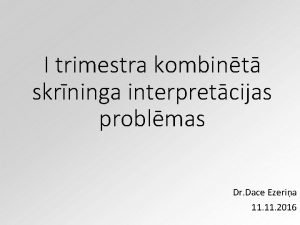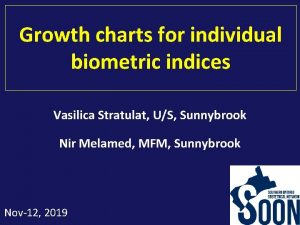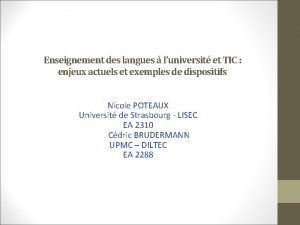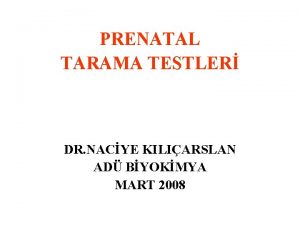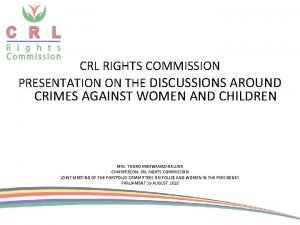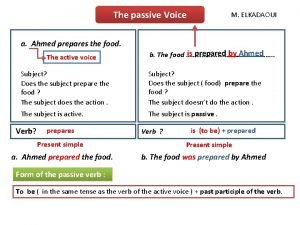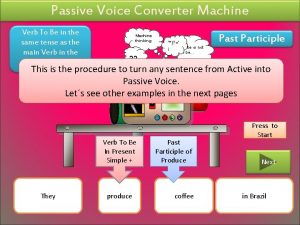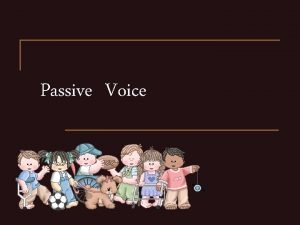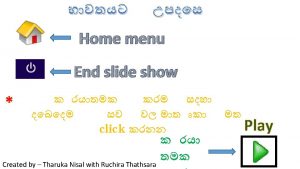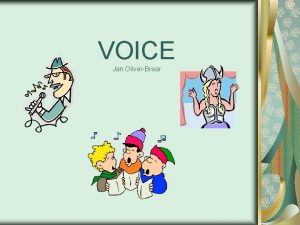CRL Speech Team Chinese Romanization for Chinese Voice



























- Slides: 27

CRL Speech Team Chinese Romanization for Chinese Voice Browsing IBM China Research Lab © 2003 IBM Corporation

CRL Speech Team Index • Motivations & Proposals • IPA. VS. Chinese Romanization • Chinese Romanization Standards • Implementations of Chinese Romanization in SSML • Extensions for other languages © 2003 IBM Corporation

CRL Speech Team Motivations & Proposals © 2003 IBM Corporation

CRL Speech Team IBM Speech Synthesis System • IBM speech synthesis system support about 20 languages. • For Asian Language, we cover: – Mandarine, – Cantonese, – Korean, – Japanese, – Thai. © 2003 IBM Corporation

CRL Speech Team Pronunciations Annotations are important for Chinese • A Chinese character represents a meaning more than a pronunciation. • The homograph phenomenon is very common for Chinese characters. • So it will be very helpful if the pronunciation can be given explicitly. © 2003 IBM Corporation

CRL Speech Team Proposals • We propose to use Chinese Romanization to annotate Chinese pronunciation in “phoneme” element. • We also propose SSML to use diverse predefined and widely used pronunciation annotation standards for different languages. • Thus SSML can be more easily accepted and used around the world. • Note: Chinese Romanization = Hanyu Pinyin in this PPT. © 2003 IBM Corporation

CRL Speech Team IPA. VS. Chinese Romanization © 2003 IBM Corporation

CRL Speech Team Comparison Rule: Goal of SSML • The goal of SSML is to “provide a rich, XML-based markup language for assisting the generation of synthetic speech in Web and other applications”. • To reach the goal, we need more and more users of SSML, such as ordinary Web applications developers, to learn and use the SSML easily. • So, we need to define the SSML based on ordinary people’s knowledge and skill rather than professional linguistics’ knowledge. – Otherwise, it will be a long way for SSML be widely accepted and used around the world. © 2003 IBM Corporation

CRL Speech Team IPA is not very fit for Chinese • IPA tries to collect an exhaustive set of pronunciations for all kinds of languages. – It has become very complicated and difficult to input. • A well educated Chinese adult can not annotate Chinese Pronunciation in IPA without special training. – IPA is not very popular in China. • Special linguistic phenomena in Chinese, such as tone, retroflex, can not be conveniently described by IPA. © 2003 IBM Corporation

CRL Speech Team Chinese Romanization is fit for Chinese • Chinese Romanization is specially designed only for Chinese instead of all languages. – Adding ‘r’ in the end to describe a “retroflex” syllable. – Adding ‘tone’ attribute to describe the tone. • Chinese Romanization is widely used and learnt. – Chinese people learn Chinese Romanization in primary school. – Many foreigners begin to learn Chinese by Chinese Romanization. – Chinese Romanization is widely used to input Chinese Characters on computer. • Chinese government has brought into effect a standard for Chinese Romanization. – It is in effect for education, publishing, information processing and other related industries in China. © 2003 IBM Corporation

CRL Speech Team Chinese Romanization Standards © 2003 IBM Corporation

CRL Speech Team Chinese Romanization Standard • The writing rules of Chinese Romanization conform to P. R. C state standard “Basic rules for Hanyu Pinyin Orthography” [1] published by (CSBQTS) in 1996. • This Orthography is based on “Hanyu Pinyin Schema” published in 1958. • According to the naming method of alphabet, we propose to use “x-CSBQTS-96” to represent Chinese Romanization alphabet. However, we also propose to use “x-Pinyin-96”, which is easier to remember. * CSBQTS: China State Bureau of Quality and Technical Supervision © 2003 IBM Corporation

CRL Speech Team Hanyu Pinyin Schema (published in 1958) • Character Set. – 25 characters, all from ‘a’ to ‘z’ except ‘ü’. – (For easy to input on computer: ü is replaced by v. ) • Initial Set: – b, p m, f, d, t, n, l, g, k, h, j, q, x, zh, ch, sh, r, z, c, s • Final Set: – i, u, ü, a , ia, ua, o, uo, e, ie, eü, ai, uai, ei, uei, – ao, iao, ou, iou, an, ian, uan, üan, en, in, uen, ün – ang, iang, uang, eng, ing, ueng, ong, iong, • Tone Annotation: – mā , má, mǎ, mà, ma • Separator: ' – pi’ao © 2003 IBM Corporation

CRL Speech Team Pinyin VS. IPA © 2003 IBM Corporation

CRL Speech Team Basic rules for Hanyu Pinyin Orthography (published in 1996) 1. Words are the basic units for spelling the Chinese Common Language. (Space is used to separate Word) – – rén (person/people), péngyou (friend[s]), túshūguǎn (library/libraries) wǒrén hé nóngmín (Workers and Farmers) 2. Structures of two or three syllables that indicate a complete concept are linked: – quánguó (the whole nation), duìbuqǐ (sorry), 3. Separate terms with more than 4 syllables if they can be separated into words, otherwise link all the syllables: – wúfèng gāngbǐ (seamless pen), Hóngshízìhuì (Red Cross) © 2003 IBM Corporation

CRL Speech Team Basic rules for Hanyu Pinyin Orthography (published in 1996) 4. Reduplicated monosyllabic words are linked, but reduplicated disyllabic words are separated: – rénrén (everybody), chángshi (give it a try) 5. In certain situations, for the purpose of making it convenient to read and understand the words, a hyphen can be added: – huán-bǎo (environmental protection), shíqī-bā suì (17 or 18 years old) © 2003 IBM Corporation

CRL Speech Team Implementations of Chinese Romanization in SSML © 2003 IBM Corporation

CRL Speech Team Implementation 1 • • <? xml version="1. 0"? > <speak version="1. 0" xmlns="http: //www. w 3. org/2001/10/synthesis" xmlns: xsi="http: //www. w 3. org/2001/XMLSchema-instance" xsi: schema. Location="http: //www. w 3. org/2001/10/synthesis http: //www. w 3. org/TR/speech-synthesis/synthesis. xsd" xml: lang="zh-CH"> <phoneme alphabet=" x-CSBQTS-96" ph="duìbuqǐ"> 对不起 </phoneme> • <!-- This is an example of Chinese Romanization Standard Tone Annotation--> • </speak> • © 2003 IBM Corporation

CRL Speech Team Implementation 2 • • <? xml version="1. 0"? > <speak version="1. 0" xmlns="http: //www. w 3. org/2001/10/synthesis" xmlns: xsi="http: //www. w 3. org/2001/XMLSchema-instance" xsi: schema. Location="http: //www. w 3. org/2001/10/synthesis http: //www. w 3. org/TR/speech-synthesis/synthesis. xsd" xml: lang="zh-CH"> <phoneme alphabet="x-CSBQTS-96" ph="dui 4 bu 0 qi 3"> 对不起 </phoneme> • <!-- This is an example of Chinese Romanization • using number to describe tone --> • </speak> © 2003 IBM Corporation

CRL Speech Team Comparison between Two implementations Implementation 1: <phoneme alphabet=" x-CSBQTS-96" ph="duìbuqǐ"> 对不起 </phoneme> Implementation 2: <phoneme alphabet="x-CSBQTS-96"ph="dui 4 bu 0 qi 3"> 对不起 </phoneme> Note: "x-CSBQTS-96" may be replaced by "x-Pinyin-96" © 2003 IBM Corporation

CRL Speech Team Extensions for other languages © 2003 IBM Corporation

CRL Speech Team Extension for Cantonese • The Linguistic society of Hong Kong has published a simple, easy-to-learn and easy-to-use “LSHK Cantonese Romanization Scheme” in 1993. • This scheme is widely adopted in various areas: education, Cantonese information process and computer input method, etc. • So we also propose to use “The LSHK Cantonese Romanization Scheme” to annotate Cantonese pronunciation. © 2003 IBM Corporation

CRL Speech Team Extension for more languages • Though it is possible to form up a general standard to annotate all languages’ pronunciation, such a standard may become very complex to use. • Another way is to use the predefined and widely accepted pronunciation annotation standards for different language. • At least, these diverse standards should be an important complement to the general standard. © 2003 IBM Corporation

CRL Speech Team Thank you! © 2003 IBM Corporation

CRL Speech Team Korea Romanization Meaning in English 밥 pap rice 불고기 pul go gi broiled beef 갈비찜 kal bi jjim beef rib stew 만두 man tu dumplings 홍차 hong ch'a tea 콜라 k'ol la cola 우유 u yu milk It is used in our Korea Speech Synthesis System. © 2003 IBM Corporation

CRL Speech Team Japanese Romanization • Japanese: – まだ覚えているでしょう 波音に包まれて • Japanese Romanization: – mada oboeteiru deshou nami oto ni tsutsumarete • English meaning: – Do you remember being surrounded by the sound of tide? © 2003 IBM Corporation

CRL Speech Team Discussion of “Word” • What is the definition of “Word” in Chinese? – Prosodic Word or Grammar Word • 你来还是不来?nǐ lái háishi bù lái? • Is “不来” a word? • What is the difference between ‘Word’ & ‘break’? – The misunderstanding problem can be solved by adding ‘break’. • Can Word information be handled by ‘Hanyu Pinyin Orthography’? – In ‘Hanyu Pinyin Orthography’, space is used to separate words. © 2003 IBM Corporation
 Crl iconnect
Crl iconnect Mātes vecuma risks t21
Mātes vecuma risks t21 Crl percentile chart
Crl percentile chart Crl unistra
Crl unistra Crl alliance medical
Crl alliance medical Crl ölçüm tablosu
Crl ölçüm tablosu Crl rights commission roles
Crl rights commission roles Anglo chinese school
Anglo chinese school A sentence in the active voice is in the pattern
A sentence in the active voice is in the pattern Chart of active and passive voice
Chart of active and passive voice Passive voice to active voice converter
Passive voice to active voice converter Present indefinite tense
Present indefinite tense Passive voicr
Passive voicr Passive voice vs active voice
Passive voice vs active voice Going native project management
Going native project management Team spirit becomes team infatuation
Team spirit becomes team infatuation The white team cheers for the blue team, just like
The white team cheers for the blue team, just like Kontinuitetshantering
Kontinuitetshantering Novell typiska drag
Novell typiska drag Nationell inriktning för artificiell intelligens
Nationell inriktning för artificiell intelligens Ekologiskt fotavtryck
Ekologiskt fotavtryck Shingelfrisyren
Shingelfrisyren En lathund för arbete med kontinuitetshantering
En lathund för arbete med kontinuitetshantering Personalliggare bygg undantag
Personalliggare bygg undantag Personlig tidbok fylla i
Personlig tidbok fylla i Sura för anatom
Sura för anatom Densitet vatten
Densitet vatten Datorkunskap för nybörjare
Datorkunskap för nybörjare

